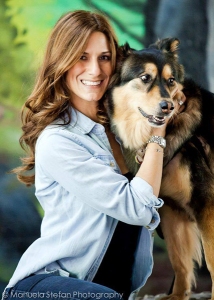Managing your child’s fear of dogs
There are plenty of people – kids and adults – that have a fear of dogs. Whether it’s a bad experience or just an innate phobia, having a fear of dogs can really impact life, especially as a child. Urban Suburban Mommy spoke with Koryn Greenspan, CEO, handler and Walker of Urban Dog Walks. Here is her professional advice as to what to do, what not to do and how to perpetuate positive change.
Few things are more truthful than seeing a child’s sheer terror or gripping fear of a dog. It breaks my heart every time. My niece was TERRIFIED of my husky/shep/collie. Clients have told stories of their paralysis around dogs due to their own personal fear as kids. In addition, I have worked hand in hand with families whose very own children were petrified at the mere thought of brining a 7 week old puppy into their home.
After years of working with dogs, and seeing various degrees of this scenario play out, I have good news … This fear, although very real, is also very fixable.
Top 10 Tips On How To Break Your Child’s Fear of Dogs:
#1Try not to shrug off this fear by suggesting that the doggie is friendly while at the same time nudging them towards a dog. YOU know and trust that dogs are beautiful animals whose primary goal is to illicit happiness and positive praise from their owner and those who are around them. Your child, however, has yet to come to that understanding, and if forced (although with good intent*) towards the dog, before he or she has time to process and change their mind, may never be able to break their fear.
#2: Take the time to talk to your child and understand where the fear is coming from. While in the understanding process, try to limit their contact with dogs just for the time being. For all you know it could something as simple as the movement of their tail OR on the other end of the spectrum, it could be a dog’s teeth and fear of bite. Whatever the cause is, if you understand it you will have a better chance of managing the exact fear when it actually occurs.
#3: Be sure never to let a dog barge at them while walking into a front door, while walking outside or while in a park.
#4: If you are going to a friend’s house, request that the dog be outside or on a leash when you get there. If you are at a park and you see a dog in the distance off leash, steer your child away from that space. If you’re walking on the street and you spot a really hyper dog who wants to jump to say hi, simply take the time to cross the road. Remember these are not forever instances; these are for the time solutions until the fear of dogs has subsided.
#5: Once the root of the fear is understood and clearly communicated, start with leash / waist training exposure. If your dog OR a dog whom you are going to see is attached to your waist on a leash, slow integration can begin.
#6: When a dog is on leash and your child is present, praise the dog for the good behaviour – and it is paramount to reassure the child that they too are doing a great job!! Remember, this is a controlled environment and your child trusts YOU. Show them your confidence and loving interaction with the dog. Be sure to maintain a distance between the dog and your child and try to go about your business as best as you can.
#7: Off leash areas. There is a great opportunity for you and your child to be in close proximity to dogs while at the same time being protected by a fence. Take your child to these parks. Let them find their own comfortable space to sit or stand and watch the dogs from the outside. They will be able to see how they interact with each other as well as with their humans. First hand exposure is the key to their understanding of how dogs work and this will help to allow them to witness how loving, playful & caring dogs really are.
#8: Book a play date in a controlled environment where there can be space between your child and the dog. Take a walk with a friend who has a dog or go to a pet friendly leashed environment and have your child watch a puppy class, or anything that will show them firsthand how patient, sweet and loyal dogs are.
#9: Educate your child on what to do if they are scared, or if a dog jumps, or if a puppy nips at their hands or ankles. Give them knowledge about what to do. Show them how to, with the use of positive reinforcement, manage and control their interactions with puppies and dogs. You would be surprised how much comfort comes from knowing what to do in scary situations. Arm them with the tools they need so they can move forward and start to build trust in dogs.
#10: Above all else, be patient, understanding and respectful of your child’s fear. It is an immense opportunity to give your child the gift of that special kind of love, loyalty and care that dogs are truly meant to give.*
 Koryn Greenspan is the CEO of Urban Dog Walks. Urban Dog Walks is an upscale, professional dog walking & dog care company she started as a passion project, and has boomed into a full dog care service providing business. Koryn is a forever pet lover, a previous professional dog walker as well as handler.
Koryn Greenspan is the CEO of Urban Dog Walks. Urban Dog Walks is an upscale, professional dog walking & dog care company she started as a passion project, and has boomed into a full dog care service providing business. Koryn is a forever pet lover, a previous professional dog walker as well as handler.
![]() https://www.facebook.com/urbandogwalks/
https://www.facebook.com/urbandogwalks/
 https://www.instagram.com/urbandogwalks.ca/
https://www.instagram.com/urbandogwalks.ca/
 https://twitter.com/UrbanDogWalks
https://twitter.com/UrbanDogWalks











What causes the fear of dogs?